Financial Decision Making Report: Ratio Analysis of Alpha Limited
VerifiedAdded on 2021/02/21
|11
|3126
|172
Report
AI Summary
This report examines financial decision-making, focusing on the roles of accounting and finance functions within organizations, using Tesco as an example. The report then analyzes the financial performance of Alpha Limited through ratio analysis, including return on capital employed, net profit margin, and current ratio. The analysis highlights the financial performance of Alpha Limited, comparing the financial data from 2017 and 2018, and offers interpretations of the trends. The report also emphasizes the importance of these financial ratios in assessing the overall health and efficiency of a company's financial strategies. The conclusion summarizes the key findings and implications of the analysis, providing insights into Alpha Limited's financial management and performance.

FINANCIAL DECISION
MAKING
MAKING
Paraphrase This Document
Need a fresh take? Get an instant paraphrase of this document with our AI Paraphraser
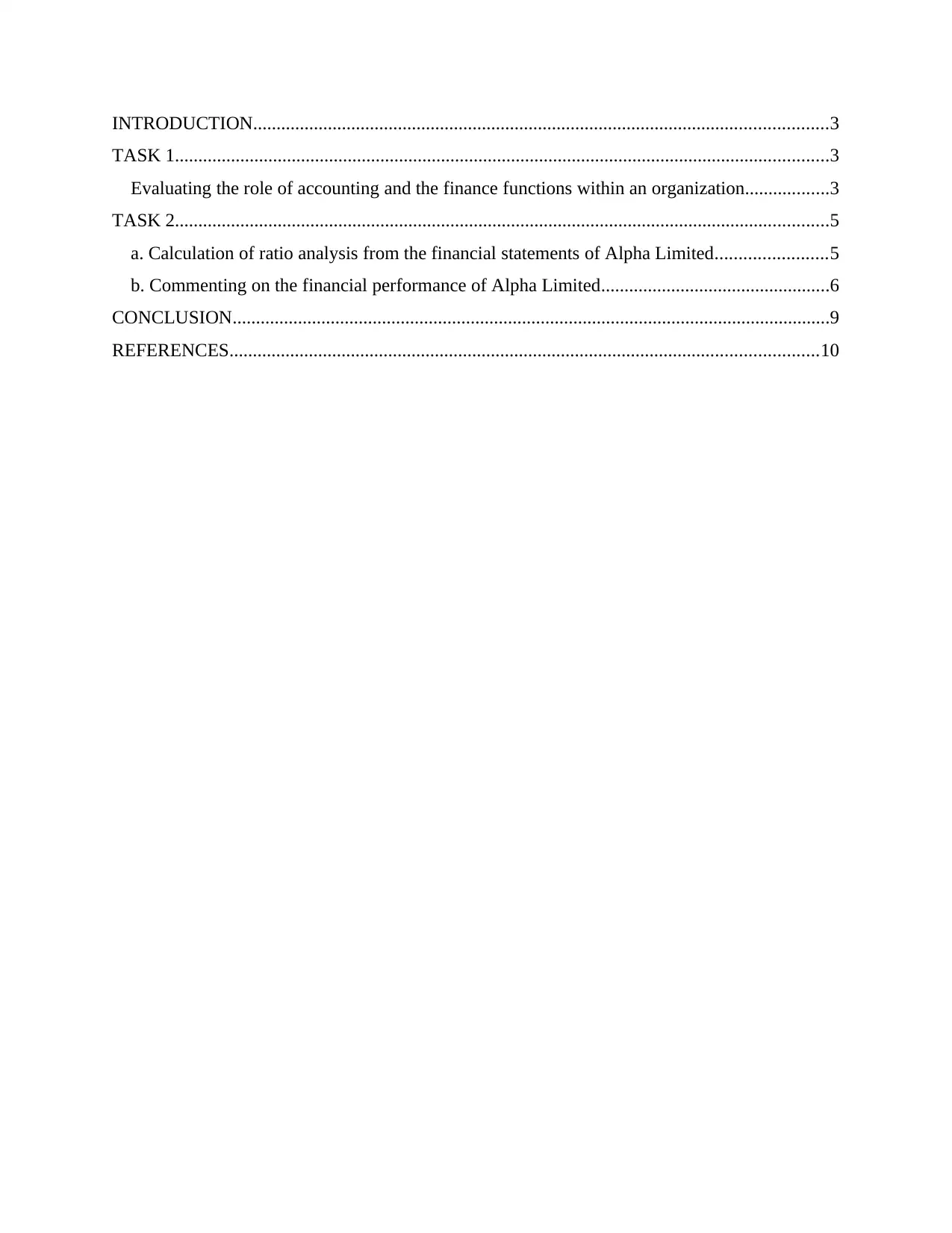
INTRODUCTION...........................................................................................................................3
TASK 1............................................................................................................................................3
Evaluating the role of accounting and the finance functions within an organization..................3
TASK 2............................................................................................................................................5
a. Calculation of ratio analysis from the financial statements of Alpha Limited........................5
b. Commenting on the financial performance of Alpha Limited.................................................6
CONCLUSION................................................................................................................................9
REFERENCES..............................................................................................................................10
TASK 1............................................................................................................................................3
Evaluating the role of accounting and the finance functions within an organization..................3
TASK 2............................................................................................................................................5
a. Calculation of ratio analysis from the financial statements of Alpha Limited........................5
b. Commenting on the financial performance of Alpha Limited.................................................6
CONCLUSION................................................................................................................................9
REFERENCES..............................................................................................................................10
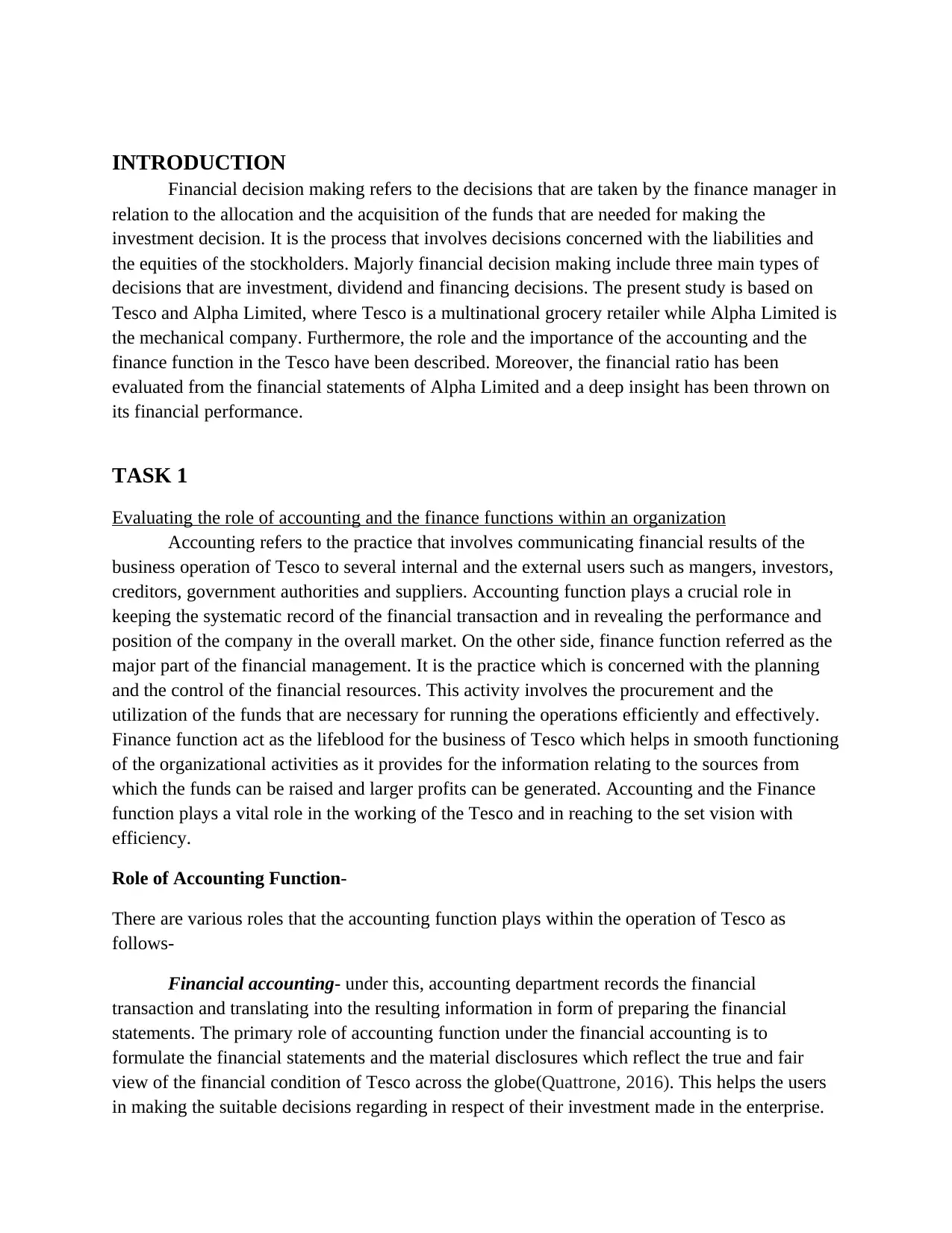
INTRODUCTION
Financial decision making refers to the decisions that are taken by the finance manager in
relation to the allocation and the acquisition of the funds that are needed for making the
investment decision. It is the process that involves decisions concerned with the liabilities and
the equities of the stockholders. Majorly financial decision making include three main types of
decisions that are investment, dividend and financing decisions. The present study is based on
Tesco and Alpha Limited, where Tesco is a multinational grocery retailer while Alpha Limited is
the mechanical company. Furthermore, the role and the importance of the accounting and the
finance function in the Tesco have been described. Moreover, the financial ratio has been
evaluated from the financial statements of Alpha Limited and a deep insight has been thrown on
its financial performance.
TASK 1
Evaluating the role of accounting and the finance functions within an organization
Accounting refers to the practice that involves communicating financial results of the
business operation of Tesco to several internal and the external users such as mangers, investors,
creditors, government authorities and suppliers. Accounting function plays a crucial role in
keeping the systematic record of the financial transaction and in revealing the performance and
position of the company in the overall market. On the other side, finance function referred as the
major part of the financial management. It is the practice which is concerned with the planning
and the control of the financial resources. This activity involves the procurement and the
utilization of the funds that are necessary for running the operations efficiently and effectively.
Finance function act as the lifeblood for the business of Tesco which helps in smooth functioning
of the organizational activities as it provides for the information relating to the sources from
which the funds can be raised and larger profits can be generated. Accounting and the Finance
function plays a vital role in the working of the Tesco and in reaching to the set vision with
efficiency.
Role of Accounting Function-
There are various roles that the accounting function plays within the operation of Tesco as
follows-
Financial accounting- under this, accounting department records the financial
transaction and translating into the resulting information in form of preparing the financial
statements. The primary role of accounting function under the financial accounting is to
formulate the financial statements and the material disclosures which reflect the true and fair
view of the financial condition of Tesco across the globe(Quattrone, 2016). This helps the users
in making the suitable decisions regarding in respect of their investment made in the enterprise.
Financial decision making refers to the decisions that are taken by the finance manager in
relation to the allocation and the acquisition of the funds that are needed for making the
investment decision. It is the process that involves decisions concerned with the liabilities and
the equities of the stockholders. Majorly financial decision making include three main types of
decisions that are investment, dividend and financing decisions. The present study is based on
Tesco and Alpha Limited, where Tesco is a multinational grocery retailer while Alpha Limited is
the mechanical company. Furthermore, the role and the importance of the accounting and the
finance function in the Tesco have been described. Moreover, the financial ratio has been
evaluated from the financial statements of Alpha Limited and a deep insight has been thrown on
its financial performance.
TASK 1
Evaluating the role of accounting and the finance functions within an organization
Accounting refers to the practice that involves communicating financial results of the
business operation of Tesco to several internal and the external users such as mangers, investors,
creditors, government authorities and suppliers. Accounting function plays a crucial role in
keeping the systematic record of the financial transaction and in revealing the performance and
position of the company in the overall market. On the other side, finance function referred as the
major part of the financial management. It is the practice which is concerned with the planning
and the control of the financial resources. This activity involves the procurement and the
utilization of the funds that are necessary for running the operations efficiently and effectively.
Finance function act as the lifeblood for the business of Tesco which helps in smooth functioning
of the organizational activities as it provides for the information relating to the sources from
which the funds can be raised and larger profits can be generated. Accounting and the Finance
function plays a vital role in the working of the Tesco and in reaching to the set vision with
efficiency.
Role of Accounting Function-
There are various roles that the accounting function plays within the operation of Tesco as
follows-
Financial accounting- under this, accounting department records the financial
transaction and translating into the resulting information in form of preparing the financial
statements. The primary role of accounting function under the financial accounting is to
formulate the financial statements and the material disclosures which reflect the true and fair
view of the financial condition of Tesco across the globe(Quattrone, 2016). This helps the users
in making the suitable decisions regarding in respect of their investment made in the enterprise.
⊘ This is a preview!⊘
Do you want full access?
Subscribe today to unlock all pages.

Trusted by 1+ million students worldwide
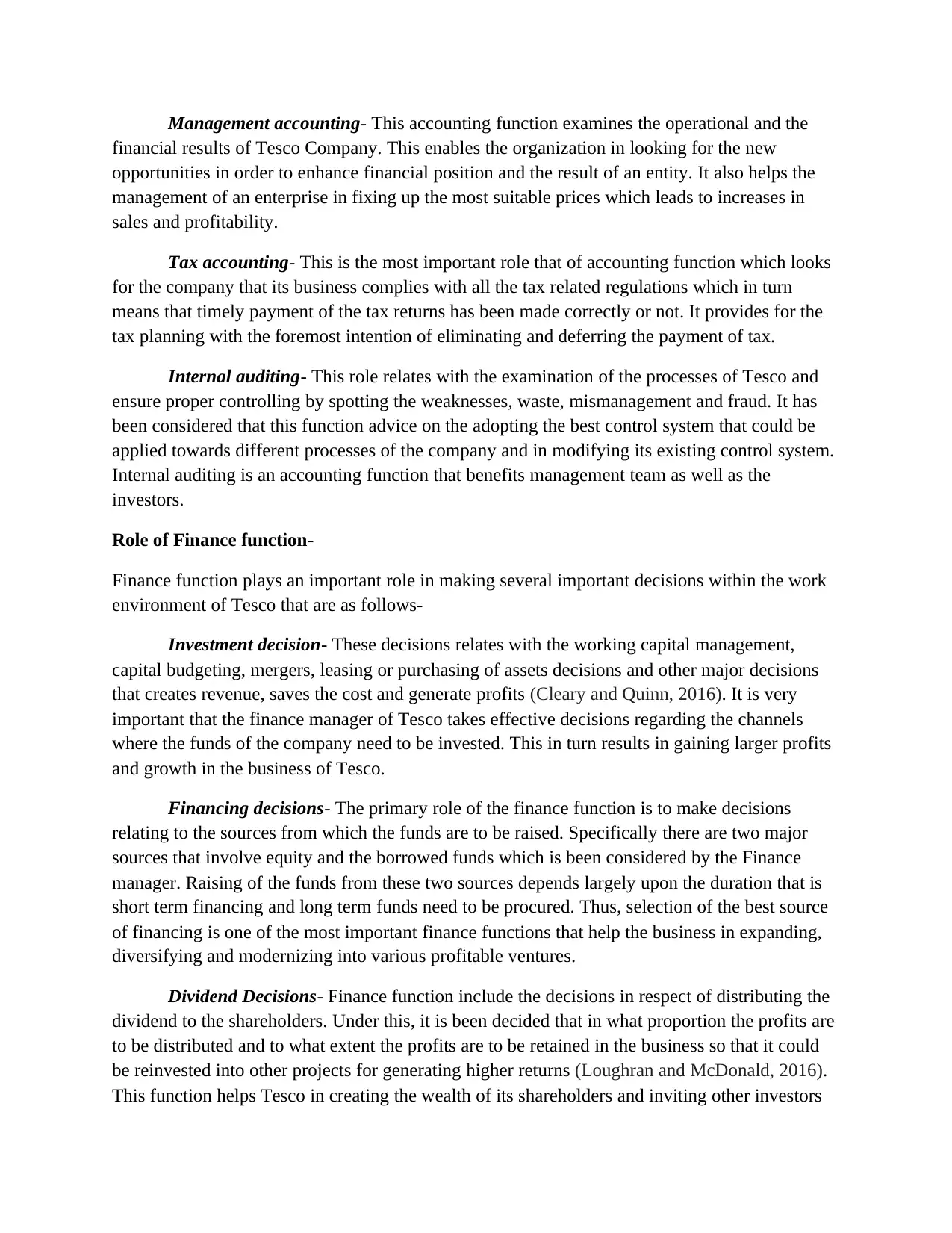
Management accounting- This accounting function examines the operational and the
financial results of Tesco Company. This enables the organization in looking for the new
opportunities in order to enhance financial position and the result of an entity. It also helps the
management of an enterprise in fixing up the most suitable prices which leads to increases in
sales and profitability.
Tax accounting- This is the most important role that of accounting function which looks
for the company that its business complies with all the tax related regulations which in turn
means that timely payment of the tax returns has been made correctly or not. It provides for the
tax planning with the foremost intention of eliminating and deferring the payment of tax.
Internal auditing- This role relates with the examination of the processes of Tesco and
ensure proper controlling by spotting the weaknesses, waste, mismanagement and fraud. It has
been considered that this function advice on the adopting the best control system that could be
applied towards different processes of the company and in modifying its existing control system.
Internal auditing is an accounting function that benefits management team as well as the
investors.
Role of Finance function-
Finance function plays an important role in making several important decisions within the work
environment of Tesco that are as follows-
Investment decision- These decisions relates with the working capital management,
capital budgeting, mergers, leasing or purchasing of assets decisions and other major decisions
that creates revenue, saves the cost and generate profits (Cleary and Quinn, 2016). It is very
important that the finance manager of Tesco takes effective decisions regarding the channels
where the funds of the company need to be invested. This in turn results in gaining larger profits
and growth in the business of Tesco.
Financing decisions- The primary role of the finance function is to make decisions
relating to the sources from which the funds are to be raised. Specifically there are two major
sources that involve equity and the borrowed funds which is been considered by the Finance
manager. Raising of the funds from these two sources depends largely upon the duration that is
short term financing and long term funds need to be procured. Thus, selection of the best source
of financing is one of the most important finance functions that help the business in expanding,
diversifying and modernizing into various profitable ventures.
Dividend Decisions- Finance function include the decisions in respect of distributing the
dividend to the shareholders. Under this, it is been decided that in what proportion the profits are
to be distributed and to what extent the profits are to be retained in the business so that it could
be reinvested into other projects for generating higher returns (Loughran and McDonald, 2016).
This function helps Tesco in creating the wealth of its shareholders and inviting other investors
financial results of Tesco Company. This enables the organization in looking for the new
opportunities in order to enhance financial position and the result of an entity. It also helps the
management of an enterprise in fixing up the most suitable prices which leads to increases in
sales and profitability.
Tax accounting- This is the most important role that of accounting function which looks
for the company that its business complies with all the tax related regulations which in turn
means that timely payment of the tax returns has been made correctly or not. It provides for the
tax planning with the foremost intention of eliminating and deferring the payment of tax.
Internal auditing- This role relates with the examination of the processes of Tesco and
ensure proper controlling by spotting the weaknesses, waste, mismanagement and fraud. It has
been considered that this function advice on the adopting the best control system that could be
applied towards different processes of the company and in modifying its existing control system.
Internal auditing is an accounting function that benefits management team as well as the
investors.
Role of Finance function-
Finance function plays an important role in making several important decisions within the work
environment of Tesco that are as follows-
Investment decision- These decisions relates with the working capital management,
capital budgeting, mergers, leasing or purchasing of assets decisions and other major decisions
that creates revenue, saves the cost and generate profits (Cleary and Quinn, 2016). It is very
important that the finance manager of Tesco takes effective decisions regarding the channels
where the funds of the company need to be invested. This in turn results in gaining larger profits
and growth in the business of Tesco.
Financing decisions- The primary role of the finance function is to make decisions
relating to the sources from which the funds are to be raised. Specifically there are two major
sources that involve equity and the borrowed funds which is been considered by the Finance
manager. Raising of the funds from these two sources depends largely upon the duration that is
short term financing and long term funds need to be procured. Thus, selection of the best source
of financing is one of the most important finance functions that help the business in expanding,
diversifying and modernizing into various profitable ventures.
Dividend Decisions- Finance function include the decisions in respect of distributing the
dividend to the shareholders. Under this, it is been decided that in what proportion the profits are
to be distributed and to what extent the profits are to be retained in the business so that it could
be reinvested into other projects for generating higher returns (Loughran and McDonald, 2016).
This function helps Tesco in creating the wealth of its shareholders and inviting other investors
Paraphrase This Document
Need a fresh take? Get an instant paraphrase of this document with our AI Paraphraser
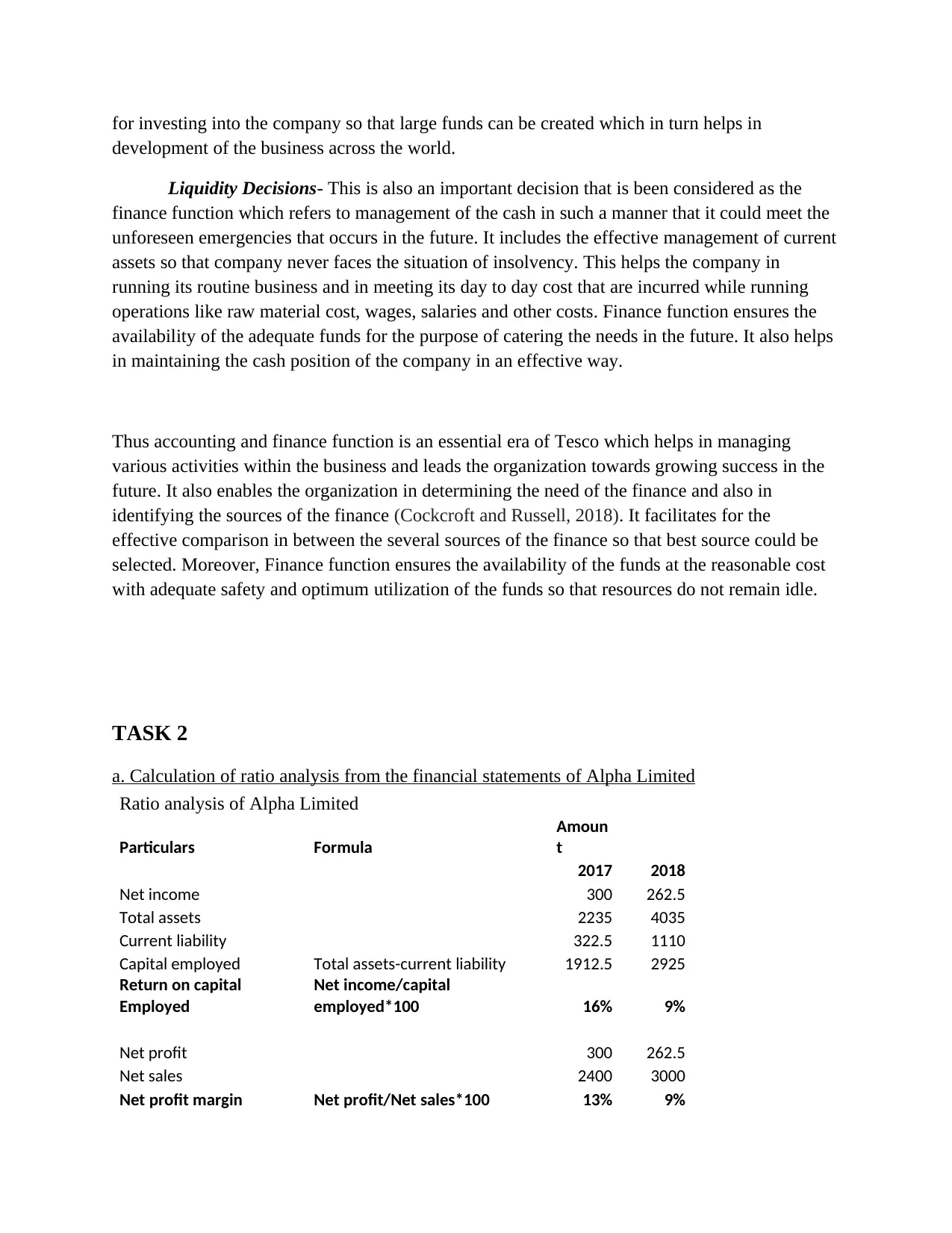
for investing into the company so that large funds can be created which in turn helps in
development of the business across the world.
Liquidity Decisions- This is also an important decision that is been considered as the
finance function which refers to management of the cash in such a manner that it could meet the
unforeseen emergencies that occurs in the future. It includes the effective management of current
assets so that company never faces the situation of insolvency. This helps the company in
running its routine business and in meeting its day to day cost that are incurred while running
operations like raw material cost, wages, salaries and other costs. Finance function ensures the
availability of the adequate funds for the purpose of catering the needs in the future. It also helps
in maintaining the cash position of the company in an effective way.
Thus accounting and finance function is an essential era of Tesco which helps in managing
various activities within the business and leads the organization towards growing success in the
future. It also enables the organization in determining the need of the finance and also in
identifying the sources of the finance (Cockcroft and Russell, 2018). It facilitates for the
effective comparison in between the several sources of the finance so that best source could be
selected. Moreover, Finance function ensures the availability of the funds at the reasonable cost
with adequate safety and optimum utilization of the funds so that resources do not remain idle.
TASK 2
a. Calculation of ratio analysis from the financial statements of Alpha Limited
Ratio analysis of Alpha Limited
Particulars Formula
Amoun
t
2017 2018
Net income 300 262.5
Total assets 2235 4035
Current liability 322.5 1110
Capital employed Total assets-current liability 1912.5 2925
Return on capital
Employed
Net income/capital
employed*100 16% 9%
Net profit 300 262.5
Net sales 2400 3000
Net profit margin Net profit/Net sales*100 13% 9%
development of the business across the world.
Liquidity Decisions- This is also an important decision that is been considered as the
finance function which refers to management of the cash in such a manner that it could meet the
unforeseen emergencies that occurs in the future. It includes the effective management of current
assets so that company never faces the situation of insolvency. This helps the company in
running its routine business and in meeting its day to day cost that are incurred while running
operations like raw material cost, wages, salaries and other costs. Finance function ensures the
availability of the adequate funds for the purpose of catering the needs in the future. It also helps
in maintaining the cash position of the company in an effective way.
Thus accounting and finance function is an essential era of Tesco which helps in managing
various activities within the business and leads the organization towards growing success in the
future. It also enables the organization in determining the need of the finance and also in
identifying the sources of the finance (Cockcroft and Russell, 2018). It facilitates for the
effective comparison in between the several sources of the finance so that best source could be
selected. Moreover, Finance function ensures the availability of the funds at the reasonable cost
with adequate safety and optimum utilization of the funds so that resources do not remain idle.
TASK 2
a. Calculation of ratio analysis from the financial statements of Alpha Limited
Ratio analysis of Alpha Limited
Particulars Formula
Amoun
t
2017 2018
Net income 300 262.5
Total assets 2235 4035
Current liability 322.5 1110
Capital employed Total assets-current liability 1912.5 2925
Return on capital
Employed
Net income/capital
employed*100 16% 9%
Net profit 300 262.5
Net sales 2400 3000
Net profit margin Net profit/Net sales*100 13% 9%
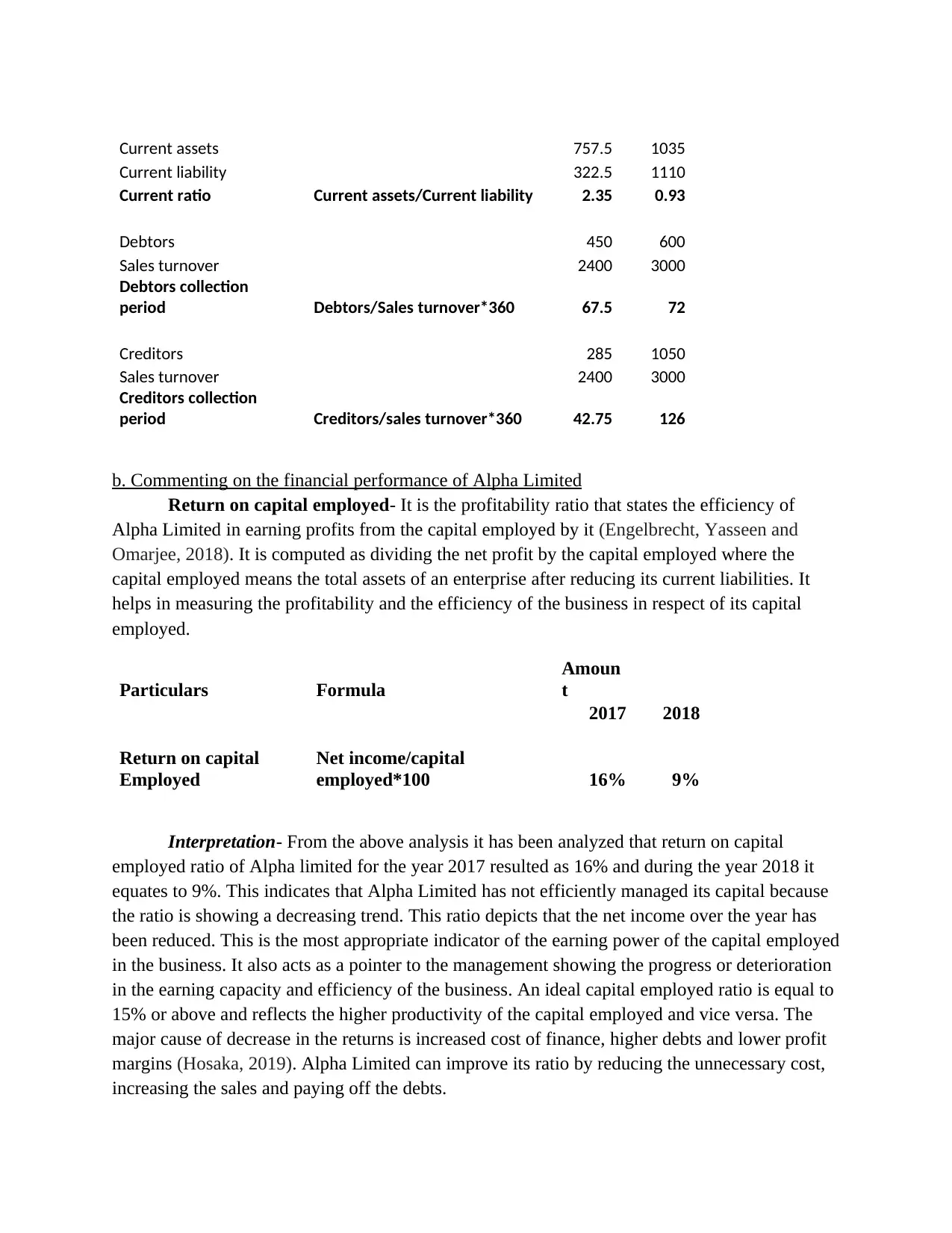
Current assets 757.5 1035
Current liability 322.5 1110
Current ratio Current assets/Current liability 2.35 0.93
Debtors 450 600
Sales turnover 2400 3000
Debtors collection
period Debtors/Sales turnover*360 67.5 72
Creditors 285 1050
Sales turnover 2400 3000
Creditors collection
period Creditors/sales turnover*360 42.75 126
b. Commenting on the financial performance of Alpha Limited
Return on capital employed- It is the profitability ratio that states the efficiency of
Alpha Limited in earning profits from the capital employed by it (Engelbrecht, Yasseen and
Omarjee, 2018). It is computed as dividing the net profit by the capital employed where the
capital employed means the total assets of an enterprise after reducing its current liabilities. It
helps in measuring the profitability and the efficiency of the business in respect of its capital
employed.
Particulars Formula
Amoun
t
2017 2018
Return on capital
Employed
Net income/capital
employed*100 16% 9%
Interpretation- From the above analysis it has been analyzed that return on capital
employed ratio of Alpha limited for the year 2017 resulted as 16% and during the year 2018 it
equates to 9%. This indicates that Alpha Limited has not efficiently managed its capital because
the ratio is showing a decreasing trend. This ratio depicts that the net income over the year has
been reduced. This is the most appropriate indicator of the earning power of the capital employed
in the business. It also acts as a pointer to the management showing the progress or deterioration
in the earning capacity and efficiency of the business. An ideal capital employed ratio is equal to
15% or above and reflects the higher productivity of the capital employed and vice versa. The
major cause of decrease in the returns is increased cost of finance, higher debts and lower profit
margins (Hosaka, 2019). Alpha Limited can improve its ratio by reducing the unnecessary cost,
increasing the sales and paying off the debts.
Current liability 322.5 1110
Current ratio Current assets/Current liability 2.35 0.93
Debtors 450 600
Sales turnover 2400 3000
Debtors collection
period Debtors/Sales turnover*360 67.5 72
Creditors 285 1050
Sales turnover 2400 3000
Creditors collection
period Creditors/sales turnover*360 42.75 126
b. Commenting on the financial performance of Alpha Limited
Return on capital employed- It is the profitability ratio that states the efficiency of
Alpha Limited in earning profits from the capital employed by it (Engelbrecht, Yasseen and
Omarjee, 2018). It is computed as dividing the net profit by the capital employed where the
capital employed means the total assets of an enterprise after reducing its current liabilities. It
helps in measuring the profitability and the efficiency of the business in respect of its capital
employed.
Particulars Formula
Amoun
t
2017 2018
Return on capital
Employed
Net income/capital
employed*100 16% 9%
Interpretation- From the above analysis it has been analyzed that return on capital
employed ratio of Alpha limited for the year 2017 resulted as 16% and during the year 2018 it
equates to 9%. This indicates that Alpha Limited has not efficiently managed its capital because
the ratio is showing a decreasing trend. This ratio depicts that the net income over the year has
been reduced. This is the most appropriate indicator of the earning power of the capital employed
in the business. It also acts as a pointer to the management showing the progress or deterioration
in the earning capacity and efficiency of the business. An ideal capital employed ratio is equal to
15% or above and reflects the higher productivity of the capital employed and vice versa. The
major cause of decrease in the returns is increased cost of finance, higher debts and lower profit
margins (Hosaka, 2019). Alpha Limited can improve its ratio by reducing the unnecessary cost,
increasing the sales and paying off the debts.
⊘ This is a preview!⊘
Do you want full access?
Subscribe today to unlock all pages.

Trusted by 1+ million students worldwide
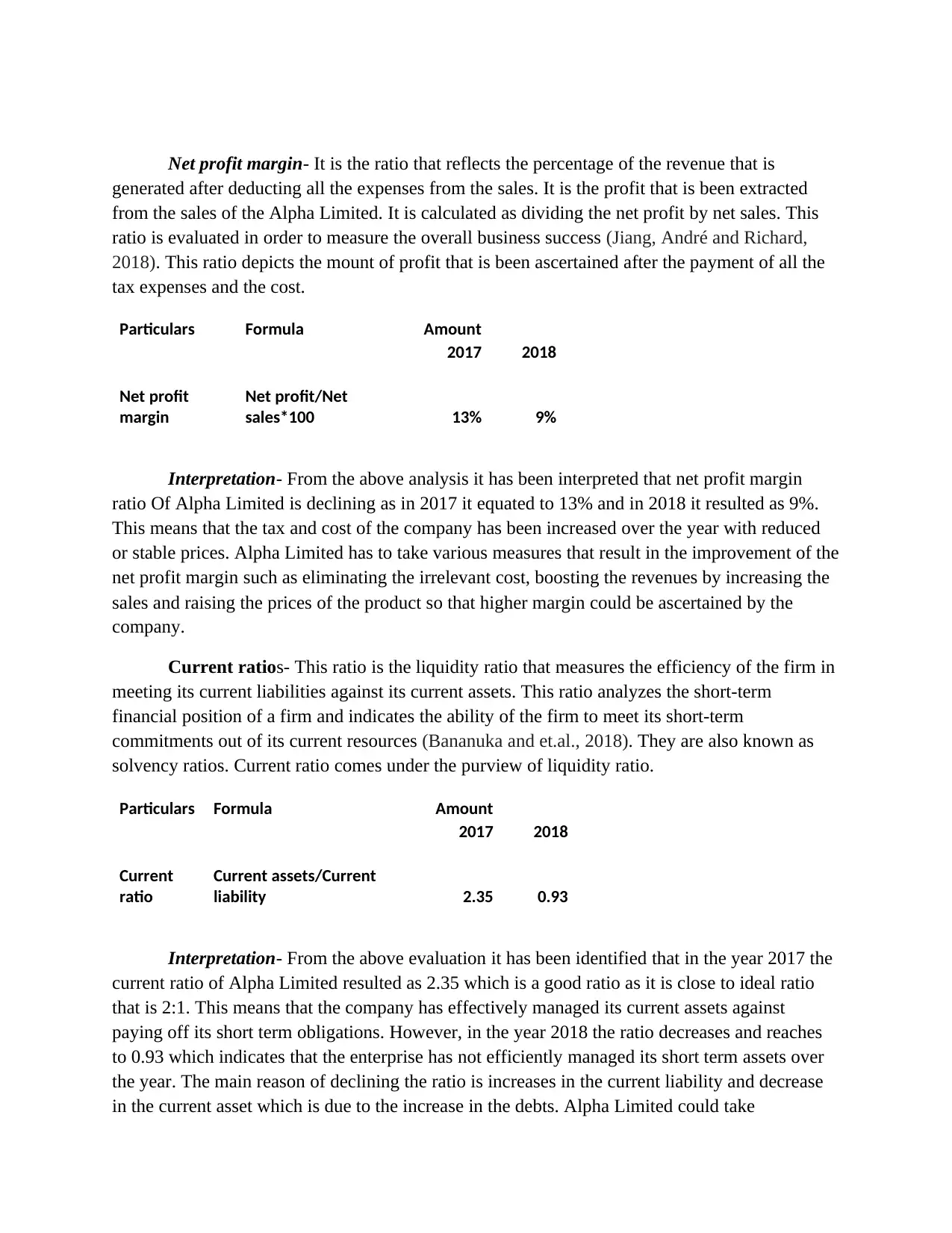
Net profit margin- It is the ratio that reflects the percentage of the revenue that is
generated after deducting all the expenses from the sales. It is the profit that is been extracted
from the sales of the Alpha Limited. It is calculated as dividing the net profit by net sales. This
ratio is evaluated in order to measure the overall business success (Jiang, André and Richard,
2018). This ratio depicts the mount of profit that is been ascertained after the payment of all the
tax expenses and the cost.
Particulars Formula Amount
2017 2018
Net profit
margin
Net profit/Net
sales*100 13% 9%
Interpretation- From the above analysis it has been interpreted that net profit margin
ratio Of Alpha Limited is declining as in 2017 it equated to 13% and in 2018 it resulted as 9%.
This means that the tax and cost of the company has been increased over the year with reduced
or stable prices. Alpha Limited has to take various measures that result in the improvement of the
net profit margin such as eliminating the irrelevant cost, boosting the revenues by increasing the
sales and raising the prices of the product so that higher margin could be ascertained by the
company.
Current ratios- This ratio is the liquidity ratio that measures the efficiency of the firm in
meeting its current liabilities against its current assets. This ratio analyzes the short-term
financial position of a firm and indicates the ability of the firm to meet its short-term
commitments out of its current resources (Bananuka and et.al., 2018). They are also known as
solvency ratios. Current ratio comes under the purview of liquidity ratio.
Particulars Formula Amount
2017 2018
Current
ratio
Current assets/Current
liability 2.35 0.93
Interpretation- From the above evaluation it has been identified that in the year 2017 the
current ratio of Alpha Limited resulted as 2.35 which is a good ratio as it is close to ideal ratio
that is 2:1. This means that the company has effectively managed its current assets against
paying off its short term obligations. However, in the year 2018 the ratio decreases and reaches
to 0.93 which indicates that the enterprise has not efficiently managed its short term assets over
the year. The main reason of declining the ratio is increases in the current liability and decrease
in the current asset which is due to the increase in the debts. Alpha Limited could take
generated after deducting all the expenses from the sales. It is the profit that is been extracted
from the sales of the Alpha Limited. It is calculated as dividing the net profit by net sales. This
ratio is evaluated in order to measure the overall business success (Jiang, André and Richard,
2018). This ratio depicts the mount of profit that is been ascertained after the payment of all the
tax expenses and the cost.
Particulars Formula Amount
2017 2018
Net profit
margin
Net profit/Net
sales*100 13% 9%
Interpretation- From the above analysis it has been interpreted that net profit margin
ratio Of Alpha Limited is declining as in 2017 it equated to 13% and in 2018 it resulted as 9%.
This means that the tax and cost of the company has been increased over the year with reduced
or stable prices. Alpha Limited has to take various measures that result in the improvement of the
net profit margin such as eliminating the irrelevant cost, boosting the revenues by increasing the
sales and raising the prices of the product so that higher margin could be ascertained by the
company.
Current ratios- This ratio is the liquidity ratio that measures the efficiency of the firm in
meeting its current liabilities against its current assets. This ratio analyzes the short-term
financial position of a firm and indicates the ability of the firm to meet its short-term
commitments out of its current resources (Bananuka and et.al., 2018). They are also known as
solvency ratios. Current ratio comes under the purview of liquidity ratio.
Particulars Formula Amount
2017 2018
Current
ratio
Current assets/Current
liability 2.35 0.93
Interpretation- From the above evaluation it has been identified that in the year 2017 the
current ratio of Alpha Limited resulted as 2.35 which is a good ratio as it is close to ideal ratio
that is 2:1. This means that the company has effectively managed its current assets against
paying off its short term obligations. However, in the year 2018 the ratio decreases and reaches
to 0.93 which indicates that the enterprise has not efficiently managed its short term assets over
the year. The main reason of declining the ratio is increases in the current liability and decrease
in the current asset which is due to the increase in the debts. Alpha Limited could take
Paraphrase This Document
Need a fresh take? Get an instant paraphrase of this document with our AI Paraphraser
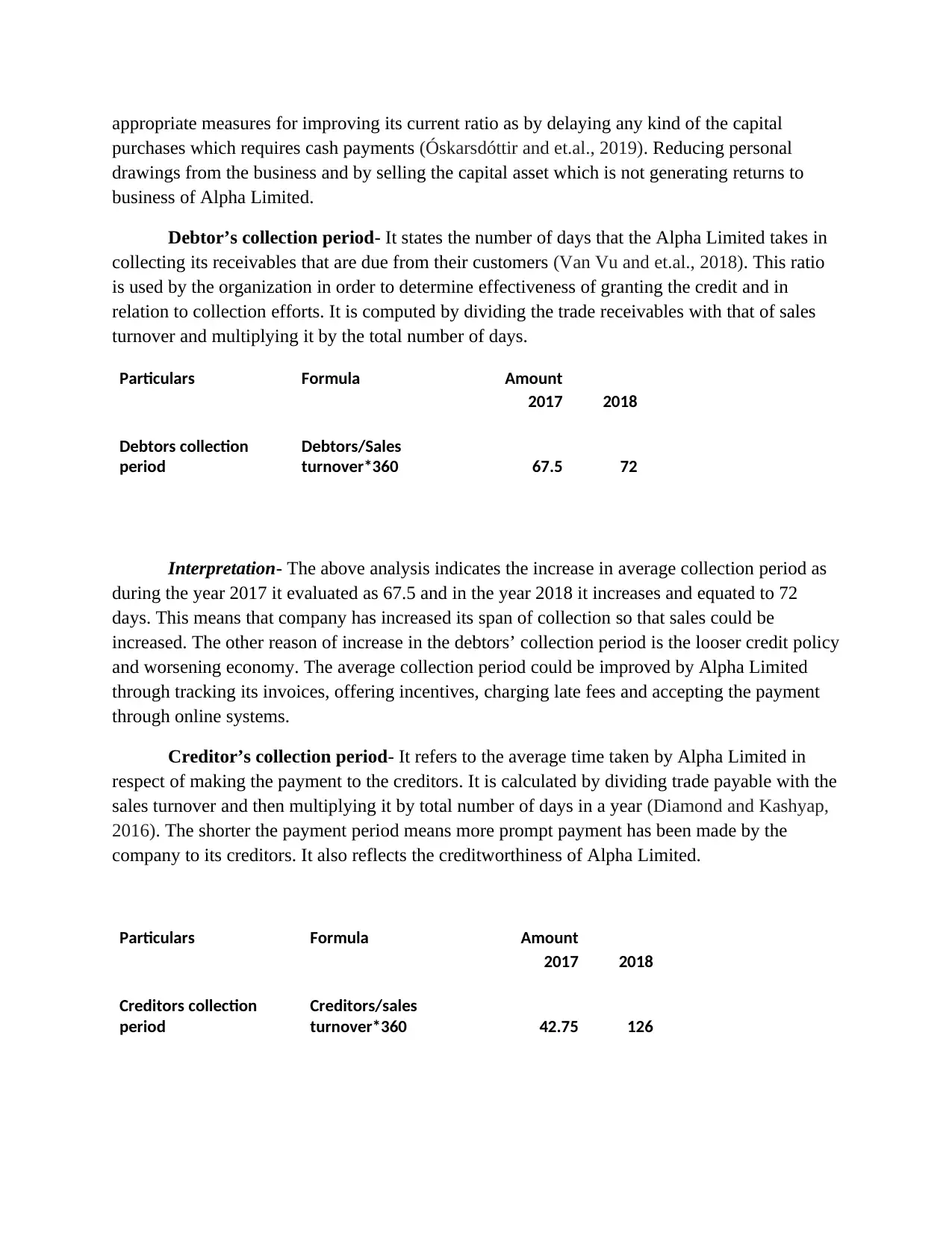
appropriate measures for improving its current ratio as by delaying any kind of the capital
purchases which requires cash payments (Óskarsdóttir and et.al., 2019). Reducing personal
drawings from the business and by selling the capital asset which is not generating returns to
business of Alpha Limited.
Debtor’s collection period- It states the number of days that the Alpha Limited takes in
collecting its receivables that are due from their customers (Van Vu and et.al., 2018). This ratio
is used by the organization in order to determine effectiveness of granting the credit and in
relation to collection efforts. It is computed by dividing the trade receivables with that of sales
turnover and multiplying it by the total number of days.
Particulars Formula Amount
2017 2018
Debtors collection
period
Debtors/Sales
turnover*360 67.5 72
Interpretation- The above analysis indicates the increase in average collection period as
during the year 2017 it evaluated as 67.5 and in the year 2018 it increases and equated to 72
days. This means that company has increased its span of collection so that sales could be
increased. The other reason of increase in the debtors’ collection period is the looser credit policy
and worsening economy. The average collection period could be improved by Alpha Limited
through tracking its invoices, offering incentives, charging late fees and accepting the payment
through online systems.
Creditor’s collection period- It refers to the average time taken by Alpha Limited in
respect of making the payment to the creditors. It is calculated by dividing trade payable with the
sales turnover and then multiplying it by total number of days in a year (Diamond and Kashyap,
2016). The shorter the payment period means more prompt payment has been made by the
company to its creditors. It also reflects the creditworthiness of Alpha Limited.
Particulars Formula Amount
2017 2018
Creditors collection
period
Creditors/sales
turnover*360 42.75 126
purchases which requires cash payments (Óskarsdóttir and et.al., 2019). Reducing personal
drawings from the business and by selling the capital asset which is not generating returns to
business of Alpha Limited.
Debtor’s collection period- It states the number of days that the Alpha Limited takes in
collecting its receivables that are due from their customers (Van Vu and et.al., 2018). This ratio
is used by the organization in order to determine effectiveness of granting the credit and in
relation to collection efforts. It is computed by dividing the trade receivables with that of sales
turnover and multiplying it by the total number of days.
Particulars Formula Amount
2017 2018
Debtors collection
period
Debtors/Sales
turnover*360 67.5 72
Interpretation- The above analysis indicates the increase in average collection period as
during the year 2017 it evaluated as 67.5 and in the year 2018 it increases and equated to 72
days. This means that company has increased its span of collection so that sales could be
increased. The other reason of increase in the debtors’ collection period is the looser credit policy
and worsening economy. The average collection period could be improved by Alpha Limited
through tracking its invoices, offering incentives, charging late fees and accepting the payment
through online systems.
Creditor’s collection period- It refers to the average time taken by Alpha Limited in
respect of making the payment to the creditors. It is calculated by dividing trade payable with the
sales turnover and then multiplying it by total number of days in a year (Diamond and Kashyap,
2016). The shorter the payment period means more prompt payment has been made by the
company to its creditors. It also reflects the creditworthiness of Alpha Limited.
Particulars Formula Amount
2017 2018
Creditors collection
period
Creditors/sales
turnover*360 42.75 126
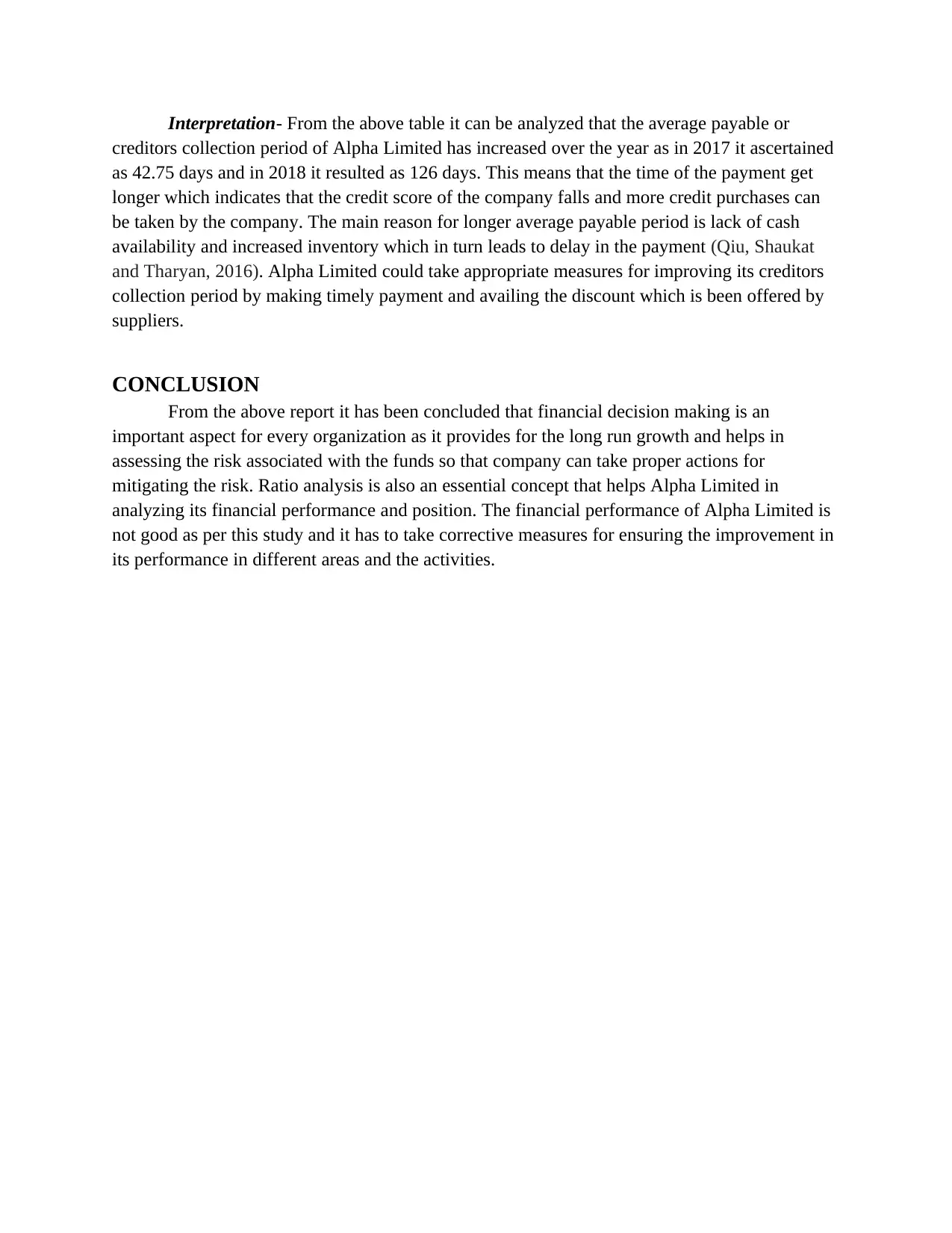
Interpretation- From the above table it can be analyzed that the average payable or
creditors collection period of Alpha Limited has increased over the year as in 2017 it ascertained
as 42.75 days and in 2018 it resulted as 126 days. This means that the time of the payment get
longer which indicates that the credit score of the company falls and more credit purchases can
be taken by the company. The main reason for longer average payable period is lack of cash
availability and increased inventory which in turn leads to delay in the payment (Qiu, Shaukat
and Tharyan, 2016). Alpha Limited could take appropriate measures for improving its creditors
collection period by making timely payment and availing the discount which is been offered by
suppliers.
CONCLUSION
From the above report it has been concluded that financial decision making is an
important aspect for every organization as it provides for the long run growth and helps in
assessing the risk associated with the funds so that company can take proper actions for
mitigating the risk. Ratio analysis is also an essential concept that helps Alpha Limited in
analyzing its financial performance and position. The financial performance of Alpha Limited is
not good as per this study and it has to take corrective measures for ensuring the improvement in
its performance in different areas and the activities.
creditors collection period of Alpha Limited has increased over the year as in 2017 it ascertained
as 42.75 days and in 2018 it resulted as 126 days. This means that the time of the payment get
longer which indicates that the credit score of the company falls and more credit purchases can
be taken by the company. The main reason for longer average payable period is lack of cash
availability and increased inventory which in turn leads to delay in the payment (Qiu, Shaukat
and Tharyan, 2016). Alpha Limited could take appropriate measures for improving its creditors
collection period by making timely payment and availing the discount which is been offered by
suppliers.
CONCLUSION
From the above report it has been concluded that financial decision making is an
important aspect for every organization as it provides for the long run growth and helps in
assessing the risk associated with the funds so that company can take proper actions for
mitigating the risk. Ratio analysis is also an essential concept that helps Alpha Limited in
analyzing its financial performance and position. The financial performance of Alpha Limited is
not good as per this study and it has to take corrective measures for ensuring the improvement in
its performance in different areas and the activities.
⊘ This is a preview!⊘
Do you want full access?
Subscribe today to unlock all pages.

Trusted by 1+ million students worldwide
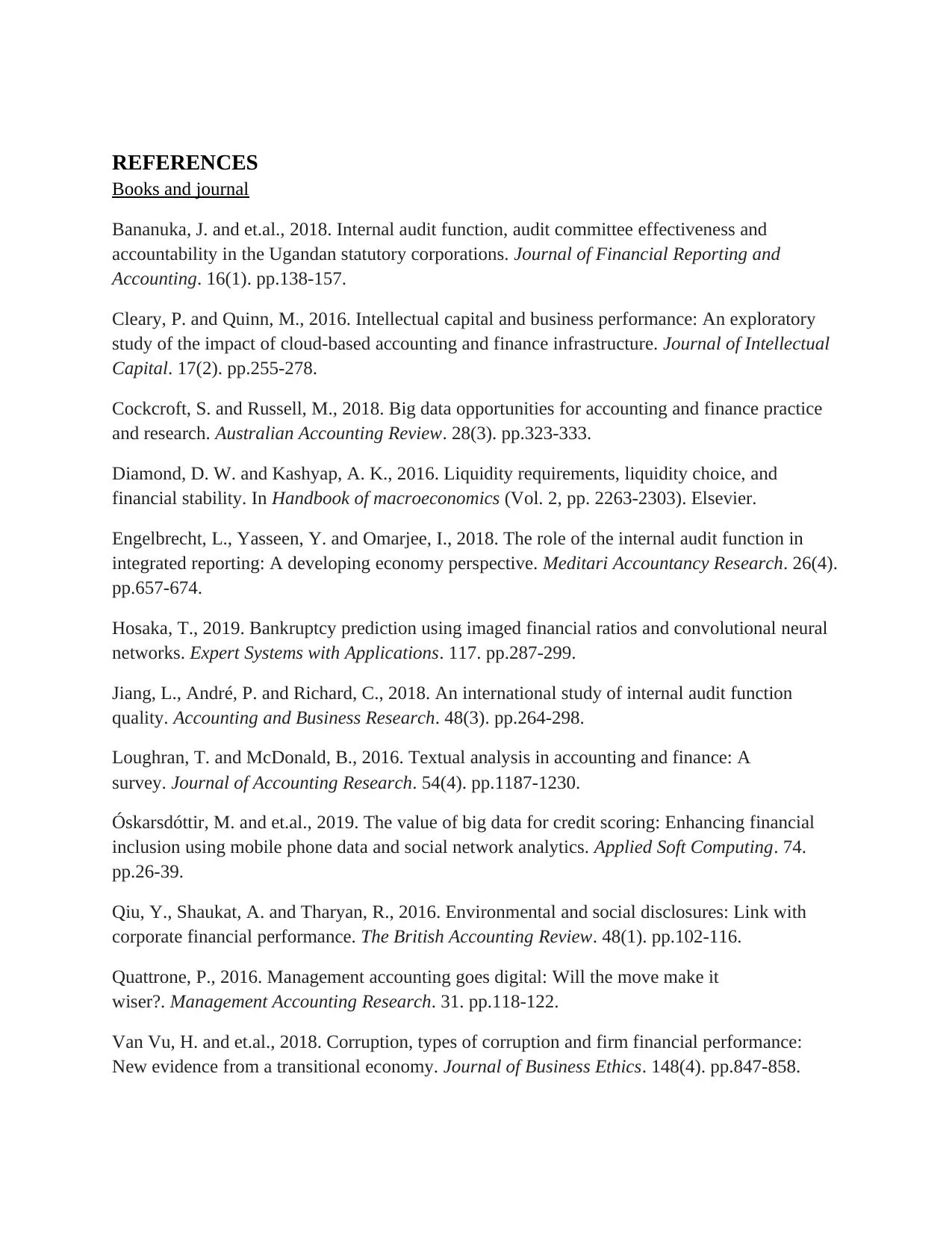
REFERENCES
Books and journal
Bananuka, J. and et.al., 2018. Internal audit function, audit committee effectiveness and
accountability in the Ugandan statutory corporations. Journal of Financial Reporting and
Accounting. 16(1). pp.138-157.
Cleary, P. and Quinn, M., 2016. Intellectual capital and business performance: An exploratory
study of the impact of cloud-based accounting and finance infrastructure. Journal of Intellectual
Capital. 17(2). pp.255-278.
Cockcroft, S. and Russell, M., 2018. Big data opportunities for accounting and finance practice
and research. Australian Accounting Review. 28(3). pp.323-333.
Diamond, D. W. and Kashyap, A. K., 2016. Liquidity requirements, liquidity choice, and
financial stability. In Handbook of macroeconomics (Vol. 2, pp. 2263-2303). Elsevier.
Engelbrecht, L., Yasseen, Y. and Omarjee, I., 2018. The role of the internal audit function in
integrated reporting: A developing economy perspective. Meditari Accountancy Research. 26(4).
pp.657-674.
Hosaka, T., 2019. Bankruptcy prediction using imaged financial ratios and convolutional neural
networks. Expert Systems with Applications. 117. pp.287-299.
Jiang, L., André, P. and Richard, C., 2018. An international study of internal audit function
quality. Accounting and Business Research. 48(3). pp.264-298.
Loughran, T. and McDonald, B., 2016. Textual analysis in accounting and finance: A
survey. Journal of Accounting Research. 54(4). pp.1187-1230.
Óskarsdóttir, M. and et.al., 2019. The value of big data for credit scoring: Enhancing financial
inclusion using mobile phone data and social network analytics. Applied Soft Computing. 74.
pp.26-39.
Qiu, Y., Shaukat, A. and Tharyan, R., 2016. Environmental and social disclosures: Link with
corporate financial performance. The British Accounting Review. 48(1). pp.102-116.
Quattrone, P., 2016. Management accounting goes digital: Will the move make it
wiser?. Management Accounting Research. 31. pp.118-122.
Van Vu, H. and et.al., 2018. Corruption, types of corruption and firm financial performance:
New evidence from a transitional economy. Journal of Business Ethics. 148(4). pp.847-858.
Books and journal
Bananuka, J. and et.al., 2018. Internal audit function, audit committee effectiveness and
accountability in the Ugandan statutory corporations. Journal of Financial Reporting and
Accounting. 16(1). pp.138-157.
Cleary, P. and Quinn, M., 2016. Intellectual capital and business performance: An exploratory
study of the impact of cloud-based accounting and finance infrastructure. Journal of Intellectual
Capital. 17(2). pp.255-278.
Cockcroft, S. and Russell, M., 2018. Big data opportunities for accounting and finance practice
and research. Australian Accounting Review. 28(3). pp.323-333.
Diamond, D. W. and Kashyap, A. K., 2016. Liquidity requirements, liquidity choice, and
financial stability. In Handbook of macroeconomics (Vol. 2, pp. 2263-2303). Elsevier.
Engelbrecht, L., Yasseen, Y. and Omarjee, I., 2018. The role of the internal audit function in
integrated reporting: A developing economy perspective. Meditari Accountancy Research. 26(4).
pp.657-674.
Hosaka, T., 2019. Bankruptcy prediction using imaged financial ratios and convolutional neural
networks. Expert Systems with Applications. 117. pp.287-299.
Jiang, L., André, P. and Richard, C., 2018. An international study of internal audit function
quality. Accounting and Business Research. 48(3). pp.264-298.
Loughran, T. and McDonald, B., 2016. Textual analysis in accounting and finance: A
survey. Journal of Accounting Research. 54(4). pp.1187-1230.
Óskarsdóttir, M. and et.al., 2019. The value of big data for credit scoring: Enhancing financial
inclusion using mobile phone data and social network analytics. Applied Soft Computing. 74.
pp.26-39.
Qiu, Y., Shaukat, A. and Tharyan, R., 2016. Environmental and social disclosures: Link with
corporate financial performance. The British Accounting Review. 48(1). pp.102-116.
Quattrone, P., 2016. Management accounting goes digital: Will the move make it
wiser?. Management Accounting Research. 31. pp.118-122.
Van Vu, H. and et.al., 2018. Corruption, types of corruption and firm financial performance:
New evidence from a transitional economy. Journal of Business Ethics. 148(4). pp.847-858.
Paraphrase This Document
Need a fresh take? Get an instant paraphrase of this document with our AI Paraphraser

1 out of 11
Related Documents
Your All-in-One AI-Powered Toolkit for Academic Success.
+13062052269
info@desklib.com
Available 24*7 on WhatsApp / Email
![[object Object]](/_next/static/media/star-bottom.7253800d.svg)
Unlock your academic potential
Copyright © 2020–2025 A2Z Services. All Rights Reserved. Developed and managed by ZUCOL.





